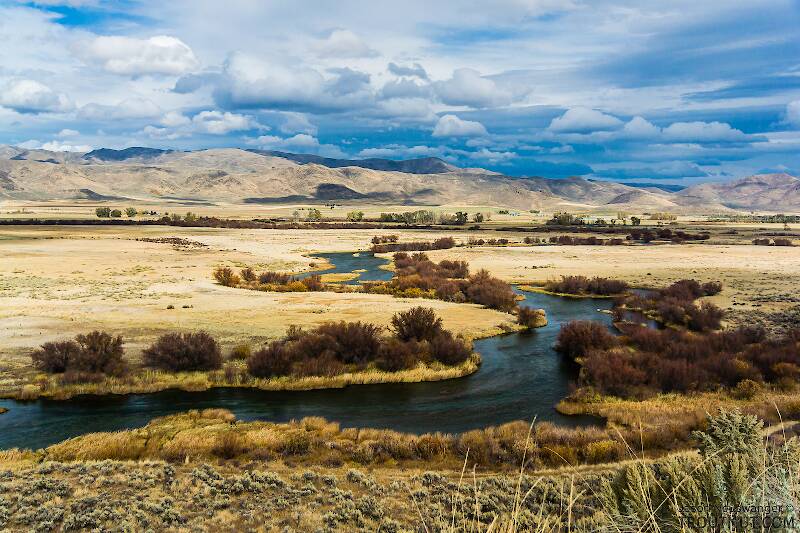
Hex Mayflies
Hexagenia limbata
The famous nocturnal Hex hatch of the Midwest (and a few other lucky locations) stirs to the surface mythically large brown trout that only touch streamers for the rest of the year.

- The prosternal horn is present.
- The mandible is clearly toothed, not formed into a uniform scraper blade.
- The seems to be only 2 major setae on the ventral edge of the hind femur.
- Chloride epithelia seem to be absent from the dorsal side of any abdominal segments.
Based on these characteristics and the ones more easily visible from the pictures, this seems to be Grammotaulius. The key's description of the case is spot-on: "Case cylindrical, made of longitudinally arranged sedge or similar leaves," as is the description of the markings on the head, "Dorsum of head light brownish yellow with numerous discrete, small, dark spots." The spot pattern on the head is a very good match to figure 19.312 of Merritt R.W., Cummins, K.W., and Berg, M.B. (2019). The species ID is based on Grammotaulius betteni being the only species of this genus known in Washington state.

Mayfly Species Plauditus cingulatus
Species Range
Physical description
Most physical descriptions on Troutnut are direct or slightly edited quotes from the original scientific sources describing or updating the species, although there may be errors in copying them to this website. Such descriptions aren't always definitive, because species often turn out to be more variable than the original describers observed. In some cases, only a single specimen was described! However, they are useful starting points.
Nymph
Head: Pale with pair of faint paramedial brown lines; antennae short reaching back little beyond bases of wing pads and somewhat darkened apically.
Thorax: Brown marks on pale background; pronotum with two submedial brown areas near anterior border and a brown area in each antero-lateral and posterolateral angle; mesonotum with pair of brownish submedian triangular areas in anterior part, these triangles seated on anterior border with acute apex posterior; more extensive brown areas laterally; wing pads pale; legs pale with prominent brown band on coxa and a longitudinal brown stroke in basal half of femur; tarsal claws pectinate.
Abdomen: Rather obscurely marked dorsum somewhat darker on segments 5-7; a submedian row of dark dots forming a double line along the dorsum and the pigmentation less dense immediately around the dark spots; pale areas antero-laterally in the segments and frequently a much more extensive pale lateral area in segment 4; segments 8-10 largely pale; venter with faint ganglionic dots and dashes in double row; lateral caudal filaments pale with indistinct dark band about halfway out; the medially directed setae in this vicinity on the filament are black and give the appearance of an obscure dark band, much less conspicuous however than the dark band in other species, e.g. P. dubium; the gills are present on segments 1-7 and have prominent tracheae.
Male Spinner
Wing length: 4 mm
Abdominal tergites 2-6 of male imago pale hyaline, the dorsal portions of posterior margins narrowly orange-brown.
Turbinate eyes circular, deep red-brown, somewhat larger than in P. dubium (now a synonym of Plauditus dubius). Thorax wholly deep blackish brown; membranous portions of pleura slightly tinged with ruddy. Fore femora deep smoky; tibiae and tarsi pale, slightly smoky. Middle and hind femora pale amber with a smoky tinge; tibiae and tarsi whitish. Wings hyaline, venation pale. Abdominal tergites 2-6 pale hyaline, the first two tergites faintly tinged with smoky; the dorsal portion of the posterior margins, especially of tergites 2 and 3, is finely orange-brown. Abdominal tergites 7-10 deep sepia-brown. Sternites 2-6 pale hyaline; 7-9 opaque, whitish tinged with sepia. Tails and forceps pale. Tracheae marked with black, forming a double black line along the spiracular area. Genitalia much as in P. dubium.
The orange-brown abdominal banding and the duller sepia brown of abdominal tergites 7-10 distinguish this species from P. dubium; it lacks the red submedian dots of P. virile (now a synonym of Plauditus virilis), and the femora are not banded; the lack of a mid-ventral row of spots separates it from P. punctiventris) now a synonym of Plauditus punctiventris).
Start a Discussion of Plauditus cingulatus
References
- Ide, F. P. 1937. Descriptions of Eastern North American Species Of Baetine Mayflies with Particular Reference to the Nymphal Stages. The Canadian Entomologist 69(11): 235-243.
- Merritt R.W., Cummins, K.W., and Berg, M.B. 2019. An Introduction to the Aquatic Insects of North America (Fifth Edition). Kendall/Hunt Publishing Company.
- Needham, James G., Jay R. Traver, and Yin-Chi Hsu. 1935. The Biology of Mayflies. Comstock Publishing Company, Inc.
Mayfly Species Plauditus cingulatus
Species Range
Resources
- NatureServe
- Integrated Taxonomic Information System
- Global Biodiversity Information Facility
- Described by McDunnough (1931)

